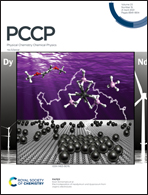Mechanism of monolayer to bilayer silicene transformation in CaSi2 due to fluorine diffusion†
Abstract
Calcium disilicide (CaSi2) possesses a layered structure composed of alternating monolayers of silicene (MLSi) and calcium. Here the mechanism by which fluorine (F) diffusion into CaSi2 leads to a phase transformation from MLSi to bilayer silicene (BLSi) was investigated. Disorder in intra-layer atomic arrangements and F aggregation were observed using HAADF-STEM in areas of low F concentration. Transformation of MLSi to BLSi in CaSi2Fx was predicted to occur at x = 0.63 based on cluster expansion (CE) and density functional theory (DFT) analyses, and these results agreed well with HAADF-STEM observations. The occurrence of F aggregation at low concentrations was also confirmed by Monte Carlo simulations using the interaction parameters obtained in CE analysis. Bader charge analysis, DFT calculations of charged states, and ab initio molecular dynamics simulations indicated that the aggregated F atoms withdrew electrons from MLSi, destabilizing the buckled honeycomb structure of MLSi in CaSi2. This charge imbalance caused the transformation of MLSi to the covalent-like BLSi.



 Please wait while we load your content...
Please wait while we load your content...